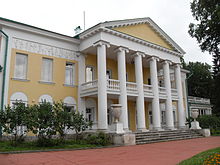- Gorki Leninskiye
-
Coordinates: 55°30′N 37°46′E / 55.5°N 37.767°E
Gorki Leninskiye (Russian: Го́рки Ле́нинские) is an urban locality (an urban-type settlement) in Leninsky District of Moscow Oblast, Russia, 10 kilometers (6.2 mi) south of Moscow city limits and the MKAD. Population: 3,597 (2010 Census preliminary results);[1] 1,729 (2002 Census);[2] 1,711 (1989 Census).[3]
The estate of Gorki belonged to various Muscovite noblemen from the 18th century, ending up in the possession of General Anatoly Reinbot, who was Governor General of Moscow in 1905 during the First Russian Revolution. After his death the estate passed to his widow, Zinaida Morozova. She engaged the most fashionable Russian architect, Fyodor Schechtel, to remodel the mansion in the then current Neoclassical style, complete with a six-column Ionic portico.
After the Soviet government moved to Moscow in 1918, the luxurious estate was nationalized and converted into Lenin's dacha. In September 1918, the Soviet leader recuperated there from an assassination attempt. He spent an increasing amount of time there as his health declined over the following years. On 15 May 1923 Lenin followed the doctor's advice and left the Moscow Kremlin for Gorki. He lived there in semi-retirement until his death on 21 January 1924.
After Lenin's death at the estate in 1924, Gorki was renamed Gorki Leninskiye. The house has been preserved as a museum, along with many of Lenin's possessions. Also located on the estate are a large museum built in 1987 concerning Lenin's life there, containing such artifacts as his Last Testament as transcribed by Krupskaya, and his apartment and office from the Kremlin, reconstructed in a separate building. A monument representing "The Death of the Leader" was unveiled in the 18th-century park in 1958.
See also
References
- ^ Федеральная служба государственной статистики (Federal State Statistics Service) (2011). "Предварительные итоги Всероссийской переписи населения 2010 года (Preliminary results of the 2010 All-Russian Population Census)" (in Russian). Всероссийская перепись населения 2010 года (All-Russia Population Census of 2010). Federal State Statistics Service. http://www.perepis-2010.ru/results_of_the_census/results-inform.php. Retrieved 2011-04-25.
- ^ Федеральная служба государственной статистики (Federal State Statistics Service) (2004-05-21). "Численность населения России, субъектов Российской Федерации в составе федеральных округов, районов, городских поселений, сельских населённых пунктов – районных центров и сельских населённых пунктов с населением 3 тысячи и более человек (Population of Russia, its federal districts, federal subjects, districts, urban localities, rural localities—administrative centers, and rural localities with population of over 3,000)" (in Russian). Всероссийская перепись населения 2002 года (All-Russia Population Census of 2002). Federal State Statistics Service. http://www.perepis2002.ru/ct/doc/1_TOM_01_04.xls. Retrieved 2010-03-23.
- ^ "Всесоюзная перепись населения 1989 г. Численность наличного населения союзных и автономных республик, автономных областей и округов, краёв, областей, районов, городских поселений и сёл-райцентров. (All Union Population Census of 1989. Present population of union and autonomous republics, autonomous oblasts and okrugs, krais, oblasts, districts, urban settlements, and villages serving as district administrative centers.)" (in Russian). Всесоюзная перепись населения 1989 года (All-Union Population Census of 1989). Demoscope Weekly (website of the Institute of Demographics of the State University—Higher School of Economics. 1989. http://demoscope.ru/weekly/ssp/rus89_reg.php. Retrieved 2010-03-23.
External links
Categories:- Urban-type settlements in Moscow Oblast
- Museums in Russia
- Vladimir Lenin
Wikimedia Foundation. 2010.

